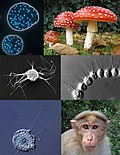Opisthokont
Opisthokonts are a broad group of eukaryotes, including both the animal and fungus kingdoms, as well as various other groups of unicellular organisms. This classification is based on the direction of the flagellum in motile cells or gametes, where the single flagellum is posterior, pushing the cell forward. The name "Opisthokont" derives from the Greek words opistho (meaning "behind") and kontos (meaning "pole" or "flagellum"), reflecting this characteristic flagellar position.
Characteristics[edit]
Opisthokonts are distinguished by their mode of motility, with the flagellum located at the rear of the cell in those species that are motile. This is in contrast to other eukaryotic groups, where flagella, if present, are typically located at the front of the moving cell. In addition to this morphological characteristic, opisthokonts share several genetic and biochemical features, including similarities in mitochondrial DNA.
Classification[edit]
The opisthokonts are divided into two main clades: the Animalia (animals) and the Fungi, along with a diverse group of unicellular organisms. These include the Choanozoa, which are closely related to animals, and various groups of protists that are more closely related to fungi. The exact relationships and classifications within the opisthokonts are subjects of ongoing research and debate.
Animalia[edit]
The Animalia kingdom encompasses all multicellular animals, from simple sponges to complex mammals. Animals are characterized by their heterotrophic mode of nutrition, consuming organic material, and their ability to move at some stage of their life cycle.
Fungi[edit]
The Fungi kingdom includes yeasts, molds, and mushrooms. Fungi are essential decomposers in ecosystems, breaking down dead organic matter. They have a unique mode of nutrition, absorbing nutrients from their environment through their cell walls.
Choanozoa[edit]
Choanozoa, or choanoflagellates, are a group of free-living unicellular and colonial flagellate eukaryotes considered to be the closest living relatives of the animals. They play a crucial role in understanding the origin of multicellularity in the animal kingdom.
Evolution[edit]
The opisthokonts are thought to have diverged from other eukaryotic groups around 1 billion years ago, with the split between animals and fungi occurring shortly thereafter. The evolution of opisthokonts is a significant area of study, as it provides insights into the origins of multicellularity and the complex life cycles of animals and fungi.
Genomics[edit]
Recent advances in genomics have provided new insights into the diversity and evolutionary history of opisthokonts. Comparative genomics has revealed that despite their differences, animals and fungi share a core set of genes, supporting their close evolutionary relationship.
Ecological and Medical Importance[edit]
Opisthokonts play vital roles in ecosystems and have significant medical and economic impacts. Fungi are crucial in nutrient cycling and as sources of antibiotics, while animals, including humans, are central to many ecological processes. Understanding the biology and evolution of opisthokonts is essential for medical research, agriculture, and biodiversity conservation.
- Opisthokont
-
Opisthokonta collage
-
Amoeba proteus with many pseudopodia
-
Mastigamoeba invertens
-
Podomonas kaiyoae
-
Nuclearia sp Nikko
-
Linear arrangement of ascospores in the asci of the fungus Sordaria macrospora
-
Rozella allomycis
-
Fibrillanosema spore
-
Sphaeroforma arctica
-
Corallochytrium limacisporum
Ad. Transform your life with W8MD's Budget GLP-1 injections from $75


W8MD offers a medical weight loss program to lose weight in Philadelphia. Our physician-supervised medical weight loss provides:
- Weight loss injections in NYC (generic and brand names):
- Zepbound / Mounjaro, Wegovy / Ozempic, Saxenda
- Most insurances accepted or discounted self-pay rates. We will obtain insurance prior authorizations if needed.
- Generic GLP1 weight loss injections from $75 for the starting dose.
- Also offer prescription weight loss medications including Phentermine, Qsymia, Diethylpropion, Contrave etc.
NYC weight loss doctor appointmentsNYC weight loss doctor appointments
Start your NYC weight loss journey today at our NYC medical weight loss and Philadelphia medical weight loss clinics.
- Call 718-946-5500 to lose weight in NYC or for medical weight loss in Philadelphia 215-676-2334.
- Tags:NYC medical weight loss, Philadelphia lose weight Zepbound NYC, Budget GLP1 weight loss injections, Wegovy Philadelphia, Wegovy NYC, Philadelphia medical weight loss, Brookly weight loss and Wegovy NYC
|
WikiMD's Wellness Encyclopedia |
| Let Food Be Thy Medicine Medicine Thy Food - Hippocrates |
Medical Disclaimer: WikiMD is not a substitute for professional medical advice. The information on WikiMD is provided as an information resource only, may be incorrect, outdated or misleading, and is not to be used or relied on for any diagnostic or treatment purposes. Please consult your health care provider before making any healthcare decisions or for guidance about a specific medical condition. WikiMD expressly disclaims responsibility, and shall have no liability, for any damages, loss, injury, or liability whatsoever suffered as a result of your reliance on the information contained in this site. By visiting this site you agree to the foregoing terms and conditions, which may from time to time be changed or supplemented by WikiMD. If you do not agree to the foregoing terms and conditions, you should not enter or use this site. See full disclaimer.
Credits:Most images are courtesy of Wikimedia commons, and templates, categories Wikipedia, licensed under CC BY SA or similar.
Translate this page: - East Asian
中文,
日本,
한국어,
South Asian
हिन्दी,
தமிழ்,
తెలుగు,
Urdu,
ಕನ್ನಡ,
Southeast Asian
Indonesian,
Vietnamese,
Thai,
မြန်မာဘာသာ,
বাংলা
European
español,
Deutsch,
français,
Greek,
português do Brasil,
polski,
română,
русский,
Nederlands,
norsk,
svenska,
suomi,
Italian
Middle Eastern & African
عربى,
Turkish,
Persian,
Hebrew,
Afrikaans,
isiZulu,
Kiswahili,
Other
Bulgarian,
Hungarian,
Czech,
Swedish,
മലയാളം,
मराठी,
ਪੰਜਾਬੀ,
ગુજરાતી,
Portuguese,
Ukrainian









